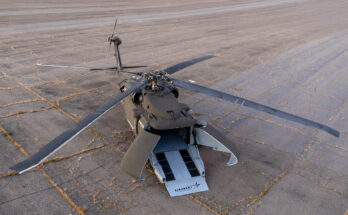The Norwegian government has released its Long-Term Defense Plan, which proposes to steadily increase defense investment to reach the NATO minimum goal of 2 percent of GDP by 2028. The document notes that this would bring the topline defense budget up NOK16.5 billion above the current-year figure of NOK61 billion ($5.8 billion) to NOK77.5 billion ($7.4 billion), an increase of 27 percent overall.
The latest document builds upon the previous iteration from the center-right coalition government of Prime Minister Erna Solberg, which was unveiled on June 17, 2016. Under that Long-Term Defense Plan, titled “Capable and Sustainable,” the government recommended providing an additional NOK165 billion (roughly $20 billion) in funding for the armed forces over the ensuing 20-year period. From 2016 through 2020 the Norwegian defense budget has since increased by an average of 5.6 percent per annum.
There are outside forces that seek to undermine unity in Norway, PM Erna Solberg underlined as she presented Norway's new Long-Term Defense Plan https://t.co/CsL8RT1Fq8
— The Barents Observer (@BarentsNews) April 17, 2020
The steady increase in defense investment continues to enjoy broad support across the political spectrum, heightened by perceptions of Russian attempts to destabilize the NATO Alliance.
Norway has made major investments in combat aircraft (the F-35), fixed-wing maritime patrol (P-8 Poseidon), the domestically produced Naval Strike Missile (NSM), the K9 Thunder self-propelled howitzer (SPH), and various upgrades to its armored vehicle fleet in recent years. On tap is the procurement of four Type 212NG (New Generation) submarines to replace its current fleet of six Ula class submarines.
A well-rounded military featuring high-capability platforms backed by robust support elements and a well-equipped reservist element (the Home Guard) enables Norway to prepare for territorial defense and protection of its airspace and maritime exclusive economic zone (EEZ) as well as participation in NATO exercises and missions. Close interoperability and cooperation with the U.S., the U.K.-led Joint Expeditionary Force and its Nordic neighbors via Nordic Defense Cooperation (NORDEFCO) further enhance Norway’s security and allow it to punch above its weight.
A capable military to defend territorial integrity and citizens is the tip of the spear for Norway’s defense approach. Credibly deterring hybrid warfare and defending its population against the threat of gray zone actions such as election meddling, disinformation and destabilization campaigns, economic coercion and cyber attacks, also figure prominently within its defense and security policy framework.
So too does investing in advanced research and the country’s defense industrial base to develop innovative technologies and enhance its influence within the NATO Alliance.
Also of particular focus for Norway is management of resources and protection of its interests in the High North, the region north of the Arctic Circle. With the effects of climate change opening up this area to increased civil, military and commercial activity, the Norwegian government – ever mindful of Russia’s view of, and claims in, the region – has increasingly shifted resources to this area, strengthening bases and improving its situational awareness.
In terms of maintaining, developing and improving military capabilities, the latest long-term plan builds upon its predecessor.
For the Army, this means new main battle tanks, mobile air defense systems and long-range precision fires (an anti-access, area-denial, or A2AD, capability). Brigade North will be enhanced with two additional maneuver battalions (bringing the total to four) plus associated tactical and logistical tail support.
For the Navy, procurement of new submarines plus upgrades to the existing Ula class boats is at the forefront. Upgrades to the Fridtjof Nansen frigates will be undertaken, as will acquisition of three new Coast Guard vessels before 2025. Planning for the next class of surface warships in order to avoid capability gaps post-2030 will also begin.
Norway’s Special Forces will receive a new helicopter platform to replace the legacy Bell 412 transport helicopters.
”Other allies recognize Norway as punching above its weight and playing a critical role in the defense of the North Atlantic and High North. ” https://t.co/NxsUGV7R51
— Petteri Kajanmaa (@PutteKaj) April 17, 2020
While Norway’s latest long-term plan will elicit some positive feedback among its NATO allies, it is not without its domestic critics who argue that the Solberg government opted for less than what the Norwegian armed forces’ defense chief, Haakon Bruun-Hanssen, recommended last fall.
They note that the government chose the lowest-cost option presented, that it only outlines a rough goal of adding 2,500 additional personnel rather than the 15,000 sought by the defense chief, and that no mention was made of replacing the lost Fridtjof Nansen frigate Helge Ingstad which sank after colliding with another vessel in late 2018. Further, they note that meeting the NATO 2 percent of GDP minimum defense spending figure will be easier to attain due to the slowdown in economic growth caused by the novel coronavirus (COVID-19) pandemic.
Yet even when taking these criticisms into account, the latest plan outlined by the government still places Norway ahead of most Alliance members when it comes to investment in resources and bolstering military readiness and response capabilities. When factoring in the likelihood that the COVID-19 crisis will force defense spending cuts across most of NATO in the coming years, with their associated freezing of capitalization projects and recruitment efforts, Norway may end up swimming against the tide.

Dan Darling is Forecast International’s director of military and defense markets. In this role, Dan oversees a team of analysts tasked with covering everything from budgeting to weapons systems to defense electronics and military aerospace. Additionally, for over 17 years Dan has, at various times, authored the International Military Markets reports for Europe, Eurasia, the Middle East and the Asia-Pacific region.
Dan's work has been cited in Defense News, Real Clear Defense, Asian Military Review, Al Jazeera, and Financial Express, among others, and he has also contributed commentary to The Diplomat, The National Interest and World Politics Review. He has been quoted in Arabian Business, the Financial Times, Flight International, The New York Times, Bloomberg and National Defense Magazine.
In addition, Dan has made guest appearances on the online radio show Midrats and on The Media Line, as well as The Red Line Podcast, plus media appearances on France 24 and World Is One News (WION).




